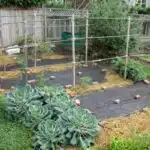Tomatoes are an essential ingredient in many cuisines worldwide. They are not only a healthy source of vitamins and minerals but also add flavor to various dishes. However, growing tomatoes can be a challenging task for amateur gardeners as they require specific care and conditions to thrive. One of the most critical factors for tomato growth is sunlight. In this article, we will explore how much sun tomatoes need to produce healthy fruits.
Tomatoes are sun-loving plants that require a minimum of six hours of direct sunlight per day to grow optimally. Sunlight provides energy for photosynthesis, which is the process that enables plants to convert carbon dioxide into sugars and starches necessary for growth and development. Insufficient sunlight can cause stunted growth, weak stems, and poor fruit production in tomatoes. However, too much sun exposure can also be detrimental as it may lead to sunscald or wilting if the soil becomes too dry. Thus, striking the right balance between light exposure and shade is crucial for successful tomato cultivation.
The Importance Of Sunlight For Tomato Growth
As a horticulturalist, I cannot overemphasize the significance of sunlight in the growth and development of tomatoes. Sunlight is an essential component of photosynthesis, a process by which plants produce food, and in this case, carbohydrates for tomato growth. Tomatoes require at least 6-8 hours of direct sunlight daily to thrive.
The importance of pruning for tomato growth cannot be overlooked. Pruning helps to improve air circulation and light penetration to the lower parts of the plant, promoting fruit ripening and reducing diseases. Additionally, it enhances the overall aesthetics of your garden or farm.
While artificial light can supplement natural sunlight during cloudy days or winter months, its effect on tomato growth may vary depending on the quality and intensity of light provided. As such, it’s advisable to use high-quality grow lights that mimic natural sunlight as much as possible for optimal results.
Understanding photosynthesis in tomatoes is critical to comprehending their need for sunlight. The process involves absorption of light energy by pigments called chlorophylls found in leaves which are then used to convert carbon dioxide into organic compounds necessary for plant growth. In the subsequent section, we’ll delve deeper into how this works and why it’s vital for healthy tomato plants.
Understanding Photosynthesis In Tomatoes
Photosynthesis is a vital process that takes place in plants, and it is the foundation of their existence. Tomatoes are no exception to this rule, as they require photosynthesis to grow and thrive. The process involves the absorption of light energy by chlorophyll molecules present in the plant leaves, which then converts carbon dioxide and water into glucose and oxygen.
The photosynthesis process in tomatoes is highly dependent on the availability of sunlight. When there is sufficient light, chlorophyll production increases, and more energy is absorbed for photosynthesis to occur. This results in healthier plants with robust foliage that can support a higher yield of fruits. However, insufficient sunlight can lead to stunted growth, reduced chlorophyll production, and poor fruit development.
To ensure that your tomato plants experience optimal photosynthesis, it is crucial to provide them with the necessary environmental conditions. These include ample sunlight exposure, adequate watering schedules, proper soil nutrients, and pest control measures. By following these four key steps below diligently, you can help your tomato plants achieve their full potential:
- Provide at least six hours of direct sunlight daily.
- Water consistently but avoid over-watering.
- Add organic matter or compost to your soil for better nutrient retention.
- Monitor your plants regularly for signs of pests or diseases.
Understanding how photosynthesis works in tomatoes can help you achieve an abundant harvest of healthy fruits. The process relies heavily on sunlight exposure levels; however, other factors play equally important roles in ensuring optimal plant growth and development. By following the four steps mentioned above diligently, you will be well on your way to cultivating thriving tomato plants with high yields – even if you have limited gardening experience or space available! In the next section, we will discuss minimum sunlight requirements for tomatoes and how best to meet these needs without compromising plant health or fruit quality.
Minimum Sunlight Requirements For Tomatoes
A tomato plant’s growth and fruit production are heavily dependent on its exposure to sunlight. In fact, sunlight is like food to the plant. Without it, a tomato plant will not thrive and produce a bountiful harvest. This is why it is essential for gardeners to understand the minimum sunlight requirements for tomatoes.
Sunlight duration is an important factor that affects a tomato plant’s growth and productivity. Tomatoes need at least 6-8 hours of direct sunlight per day to grow properly. Anything less than this amount will result in stunted growth, reduced yield, and poor fruit quality. It is also important to note that the intensity of the sunlight matters as well. Tomato plants need bright, direct light to produce their best yields.
Planting density can also affect how much sun a tomato plant receives. When planting tomatoes, it’s crucial to ensure that they have enough space between them so that each one can get enough light. Crowded plants will compete for resources and shade each other out, preventing adequate sun exposure. Gardeners should aim to space their tomato plants at least two feet apart in rows spaced three to four feet apart for optimal sunlight availability.
To achieve healthy tomato plants with high yields, gardeners must pay close attention to their sun exposure needs. However, several factors affect how much sunlight is available for tomatoes to absorb fully. In the next section, we’ll explore these factors in more detail and learn how they impact tomato growth and productivity.
Factors Affecting Sunlight Availability For Tomatoes
Sunlight is an essential factor in the growth and development of tomato plants. As a general rule, tomato plants require a minimum of 6-8 hours of direct sunlight each day to produce healthy fruits. However, the optimal amount of sunlight varies depending on various factors such as the climate, season, and location.
One way to increase the amount of sunlight available for tomato plants is by using shade cloth. Shade cloth is a woven material that can be used to filter out excess sunlight and reduce heat stress on plants during hot summer months. By placing shade cloth over tomato plants, growers can control the amount of light that reaches their crop and prevent sun damage.
Reflective mulch is another method that gardeners use to increase sunlight availability for their tomato plants. Reflective mulches reflect more light onto plant leaves as opposed to absorbing it into the soil, increasing the amount of photosynthesis occurring within the plant. This translates to better growth and higher yields.
In summary, ensuring adequate sunlight availability is crucial for optimal growth and productivity in tomatoes. Growers have several options at their disposal when it comes to managing light exposure on their crops, including shade cloth and reflective mulch. The next step in cultivating a thriving tomato crop involves choosing the right location for your plants based on factors such as soil quality and drainage.
Choosing The Right Location For Your Tomato Plants
When it comes to growing healthy and productive tomato plants, choosing the right location is crucial. In fact, it can make all the difference between a bountiful harvest and a disappointing one. Therefore, it’s essential to choose a spot that provides the ideal growing conditions for your tomato plants.
First and foremost, you need to choose the right soil for your tomato plants. Tomatoes require well-draining soil that is rich in nutrients such as nitrogen, phosphorus, and potassium. You should also ensure that the pH level of the soil is between 6.0 and 7.0 for optimal growth. Additionally, adding organic matter such as compost or manure to the soil before planting can help improve its fertility.
Another crucial aspect of growing healthy tomato plants is proper watering techniques. Consistent watering is key to ensuring that your plants get enough water without drowning them or causing root rot. It’s recommended to water tomatoes deeply once a week rather than shallowly every day. This encourages deep root growth and helps the plant access moisture during dry spells.
Choosing the right location, soil type, and watering techniques are essential factors in growing healthy tomato plants. However, maximizing sunlight exposure is just as important. In the next section, we will discuss how you can ensure your tomato plants receive enough sunshine to produce an abundant crop.
How To Maximize Sunlight Exposure For Tomatoes
Positioning tomatoes for optimal sunlight should take into account the sun’s arc and the tomato plant’s height. Taller plants will require more direct light and should be placed in a south-facing location to get maximum sun exposure.
Utilizing reflective surfaces to increase sunlight can be done by placing a light-colored mulch or tarp around the tomato plants. This will help to increase the amount of sunlight that reaches the plant.
Tomatoes can also benefit from growing close to a reflective wall or fence. This will help to reflect more direct sunlight onto the plants.
When positioning tomato plants for maximum sunlight, it is important to remember that tomatoes need at least 6 to 8 hours of direct sunlight per day for optimal growth.
Positioning Tomatoes For Optimal Sunlight
Tomatoes are one of the most popular crops grown in home gardens. They thrive in warm, sunny conditions and require ample sunlight to produce a bountiful harvest. Achieving optimal sunlight exposure is critical for tomato plants to grow healthy and robust. Therefore, positioning tomatoes in the right place is crucial to maximize their sun exposure.
Sunlight intensity plays a significant role in determining the success of growing tomatoes. Tomato plants need at least six hours of direct sunlight every day to thrive; however, more extended periods of direct sunlight can be beneficial, especially during the fruiting period. Therefore, it is essential to choose a spot with maximum sun exposure throughout the day. Southern or western-facing positions are ideal for maximizing sunlight.
Tomato variety selection also plays a vital role in determining how much sun they need. Some varieties require less sunlight than others and can still grow well in partially shaded areas. However, most tomato varieties require full sun exposure to produce high-quality fruits that are juicy and flavorful. As such, it’s important to select varieties that suit your garden location and climate conditions best so you can position them optimally for maximum sun exposure throughout their growing season.
Utilizing Reflective Surfaces To Increase Sunlight
To further maximize sunlight exposure for tomato plants, gardeners have found success in utilizing reflective surfaces. Reflective mulch is a popular option that has been proven to increase light availability by reflecting sunlight back onto the plants. This type of mulch is typically made of aluminum-coated plastic or silver-colored materials that are placed on the ground around the base of the plant. The reflective surface bounces light back up toward the plant and can increase available light by up to 12%.
Another way to utilize reflective surfaces is by using mirrors as reflectors. This method involves placing mirrors near or around tomato plants to redirect sunlight onto them. It’s important to note that this technique should be used with caution, as too much direct sunlight can cause sunscald and damage plants. Gardeners should also ensure that mirrors are positioned in a way that doesn’t create hot spots or burn nearby plants.
Overall, utilizing reflective surfaces can be an effective way to maximize sunlight exposure for tomatoes, especially in areas with limited sun exposure. Gardeners should experiment with different options, such as reflective mulch or mirrors, and monitor their results carefully. By combining proper positioning with reflective surfaces, gardeners can help their tomato plants produce healthy and abundant yields of delicious fruit.
Using Shade To Protect Tomatoes From Excessive Heat
Tomatoes require a considerable amount of sunlight to thrive, but excessive heat can cause damage to the plants. One effective way to protect them from the heat is by using shade cloth. Shade cloth is a woven material that can be placed over tomato plants, reducing the amount of direct sunlight they receive. The cloth blocks out some of the sun’s rays, creating a cooler environment for the plants.
When using shade cloth, it’s important to choose the right level of shading. Too much shade could prevent photosynthesis and slow down growth, while too little could expose the plants to excessive heat and sunburn. The optimal temperature range for tomatoes is between 65-85°F (18-29°C), so it’s best to aim for a shading level that keeps temperatures within this range.
In addition to providing relief from high temperatures, shade cloth can also protect tomato plants from pests and diseases. It creates a physical barrier that prevents insects from accessing the plants and helps reduce moisture levels, preventing fungal growth. Overall, using shade cloth is an effective way to protect your tomato plants and ensure they have the optimal conditions for healthy growth.
Signs Of Too Little Sunlight In Tomato Plants
As tomato plants grow, they require a certain amount of sunlight to thrive. When tomatoes don’t receive enough sunlight, they can experience stunted growth and even wilt. This is because tomatoes need sunlight to produce energy through photosynthesis, which is necessary for maximizing growth.
Preventing wilting in tomato plants due to lack of sunlight involves ensuring that they are planted in an area where they will receive adequate amounts of sun throughout the day. This means planting them in an area with at least six hours of direct sunlight each day. Additionally, ensuring that the soil is well-draining and rich in nutrients can also help prevent wilting and promote healthy growth.
Maximizing growth in tomato plants requires paying attention to their needs beyond just providing adequate sunlight. Proper watering, fertilization, and pruning are all important factors that can impact their overall health and productivity. By addressing these needs alongside ensuring adequate sunlight exposure, gardeners can help their tomato plants reach their full potential.
Moving forward from preventing wilting due to lack of sun exposure, it’s also important to be aware of signs that your tomato plants may be receiving too much sunlight. These signs include leaf scorching or curling and fruit cracking or splitting. In the next section, we will explore these signs further and discuss ways to mitigate the negative effects of too much sunlight on tomato plants.
Signs Of Too Much Sunlight In Tomato Plants
Excessive sunlight exposure can have detrimental effects on tomato plants, causing them to wilt and become discolored. Signs of too much sunlight in tomato plants include yellowing or browning leaves, leaf drop, and stunted growth. Additionally, excessive heat from the sun can cause heat stress in tomato plants, which can lead to reduced fruit production and diminished quality.
To prevent sun damage in tomato plants, it is essential to manage their exposure to sunlight carefully. One way to do this is by providing shade during the hottest part of the day. This can be done by using shade cloth or planting taller crops nearby that will cast a shadow over the tomatoes. Another method for managing heat stress is to water tomato plants consistently and deeply. This not only helps keep the plant cool but also ensures that it receives adequate moisture.
In summary, too much sunlight exposure can harm tomato plants and result in decreased yields. To prevent sunscald and heat stress in tomato plants, horticulturists must manage their exposure carefully through shading methods and consistent watering practices. By implementing these strategies, gardeners can ensure healthy plant growth and successful harvests.
As we have discussed how excessive sunlight exposure damages tomato plants; now let us move on to understanding the causes of sunscald in tomatoes and various ways of preventing it.
Sunscald In Tomatoes: Causes And Prevention
Sunscald in tomatoes is caused by overexposure to direct sunlight, which can lead to premature ripening, discoloration, and sunburn. Preventive measures for sunscald in tomatoes include providing adequate shade for the plants and using light-colored mulch to reflect the sun’s rays. Tomatoes that have been affected by sunscald will have reduced quality in terms of flavor, texture, and nutritional value. The intensity and duration of sunlight exposure, as well as the tomato variety and its ripeness, can also affect the likelihood of sunscald in tomatoes. Appropriate cultural practices should be employed to ensure the tomato plants are protected from direct sunlight. Finally, it is important to ensure that tomatoes receive enough sunlight to reach their full photosynthetic potential.
Causes Of Sunscald In Tomatoes
As tomato gardeners, we all know the importance of sunlight for the healthy growth of our plants. However, too much sun can be detrimental to tomatoes, causing a condition known as sunscald. This condition occurs when the fruit is exposed to direct sunlight for extended periods, leading to discoloration and damage to the skin. It is crucial to understand what causes sunscald in tomatoes to take preventative measures and effectively treat any affected plants.
One of the main causes of sunscald in tomatoes is insufficient foliage cover. When tomato plants have inadequate leaf coverage, they are unable to protect their fruit from direct sunlight. Additionally, improper pruning techniques can lead to a lack of foliage cover. To prevent this issue, it is essential to maintain proper pruning practices and ensure that your plants have sufficient foliage cover.
Another contributing factor to sunscald in tomatoes is extreme temperatures. High temperatures can cause the skin on tomato fruits to become thin and fragile, making them more susceptible to damage from the sun’s rays. As such, it’s vital to monitor temperature levels in your garden and provide shade during particularly hot days if necessary.
Prevention measures for sunscald include maintaining adequate foliage coverage around your tomato fruit and using shading materials like row covers or shade cloth during hot days. Treatment options include removing any damaged or discolored fruit immediately and increasing water intake for your plants during periods of high heat. By taking these preventative measures and utilizing treatment options when necessary, you can effectively combat sunscald in your tomato garden without sacrificing plant health or yield potential.
Preventive Measures For Sunscald In Tomatoes
One of the biggest challenges for tomato gardeners is preventing sunscald in their plants. Sunscald occurs when fruits are exposed to direct sunlight for extended periods, leading to discoloration and damage to the skin. This condition can be prevented by taking certain measures that aim to protect tomato fruits from excessive sunlight.
One effective preventive measure is providing tomato shade. Row covers or shade cloth can be used during particularly hot days or when the plants are experiencing high levels of sun exposure. Another method is to use sunscreen for plants, which is a specially formulated spray that helps protect plant leaves and fruits from harmful ultraviolet rays.
It’s also important to maintain proper watering practices and ensure that your tomato plants have adequate foliage cover. Regular watering ensures that your plants remain hydrated, while sufficient foliage cover protects fruit from direct sunlight. Additionally, proper pruning techniques can help promote healthy growth and prevent sunscald by maintaining adequate foliage coverage around your fruit.
By following these preventive measures, you can effectively combat sunscald in your tomato garden and ensure a healthy harvest of delicious tomatoes. Remember, prevention is key when it comes to protecting your plants from excessive exposure to sunlight!
Impact Of Sunscald On Tomato Quality
Sunscald is a common problem that affects tomato plants, and it can have a significant impact on the quality of the fruits. When tomatoes are exposed to excessive sunlight, their skin may become discolored and damaged, which can affect their taste, texture, and overall appearance. As such, preventing sunscald is crucial for gardeners who want to produce high-quality tomatoes.
Fortunately, there are several prevention methods that can help gardeners protect their plants from sunscald. Providing shade through the use of row covers or shade cloth can help reduce direct exposure to sunlight. Additionally, regular watering and proper pruning techniques can help maintain adequate foliage coverage around the fruit, which provides additional protection against sun damage.
The effects of sunscald on plant health go beyond just cosmetic damage to the fruit. Excessive exposure to sunlight can also lead to stress in tomato plants, which can make them more susceptible to other diseases and pests. By taking proactive measures to prevent sunscald and ensure proper plant care, gardeners can not only protect the quality of their tomatoes but also maintain the overall health and vitality of their plants.
Wilting In Tomatoes: Causes And Prevention
Imagine walking into your garden to check on your lovely tomato plants, only to find them wilting and drooping. This can be a heartbreaking sight for any gardener who has put in time and effort to grow these beautiful plants. Wilting in tomatoes is a common problem, but it doesn’t have to be a death sentence for your plants.
One of the main causes of wilting in tomatoes is improper watering techniques. Overwatering or underwatering can both lead to wilting, so it’s important to find the right balance. The key is to water deeply and infrequently, allowing the soil to dry out slightly between watering sessions. This will encourage deep root growth and prevent water from sitting on the surface where it can promote fungal growth.
Preventing wilting also involves proper monitoring of your plants’ moisture levels. One way to do this is by using a moisture meter or simply sticking your finger into the soil up to the second knuckle. If it feels dry at that depth, it’s time to water. By following these watering techniques and regularly checking moisture levels, you can prevent wilting in your tomato plants and ensure healthy growth throughout the season.
Transition: Now that we’ve covered preventing wilting through proper watering techniques, let’s dive into another important factor for tomato plant health: sunlight exposure. How much sun do tomatoes need? We’ll explore this topic in the following section.
How To Monitor Sunlight Exposure For Tomatoes
Tomatoes are sun-loving plants that require about six to eight hours of direct sunlight per day. This is because sunlight is essential for photosynthesis, the process by which plants manufacture food. Without adequate sunlight, tomatoes won’t develop properly and may produce fewer flowers and fruit. Therefore, it’s crucial to monitor the amount of sunlight your tomato plants receive.
One way to measure sunlight exposure is by using a sunlight measurement tool such as a light meter or a smartphone app. These tools can help you determine how much light your tomato plants are receiving and whether they need more or less sunlight. This information can be used to adjust your watering schedule accordingly so that your plants get optimal sunlight exposure.
Another way to ensure that your tomato plants are getting enough sunlight is by adjusting their location in the garden. If your tomato plants are not receiving enough light, consider moving them to a sunnier spot in the garden where they can receive more direct sunlight. Additionally, pruning your plants can also help promote better air circulation and reduce shading between plants, resulting in better access to sunlight.
As we’ve seen, monitoring and adjusting sunlight exposure for tomatoes is crucial for promoting healthy growth and increasing yields. In the next section, we’ll discuss how to adjust sunlight exposure as tomato plants grow and develop over time. By following these tips, you can ensure that your tomato plants get the right amount of light they need to thrive.
Adjusting Sunlight Exposure As Tomatoes Grow
Now that we know how to monitor sunlight exposure for tomatoes, it is important to adjust the timing of sunlight exposure as the plants grow. The amount of sun required by tomato plants changes as they mature, and it is essential to provide them with the optimal amount of light throughout their growth cycle. Generally, tomato plants require 6-8 hours of direct sunlight per day to thrive, but this can vary based on climate and soil conditions.
When adjusting the timing of sunlight exposure for tomatoes, it is important to consider the time of day when the sun’s intensity is strongest. Typically, this will be in the middle of the day when temperatures are highest. To avoid scorching or damaging your tomato plants, it may be necessary to provide shade during this period or move them to a more shaded area. Alternatively, if you live in an area with limited natural light, you can supplement your plants’ needs with artificial lighting.
Artificial lighting can be used to supplement natural sunlight for tomato plants. This method involves using lamps or other sources of artificial light to provide additional light for your plants. When using artificial lighting, it is important to match the wavelength and intensity of natural sunlight as closely as possible. This will ensure that your plants receive all the nutrients they need for optimal growth and development. Other factors affecting tomato growth and health include soil quality, temperature, humidity levels, water availability and disease control measures which requires further research and consideration.
Other Factors Affecting Tomato Growth And Health
A tomato plant requires several factors for optimal growth and fruit production. While sun exposure plays a significant role, other factors also affect its growth and health. Think of the tomato plant as a human body – just like how we need sunlight, water, and nutrients to thrive, tomatoes require more than just sunshine.
Soil nutrients are critical to ensure healthy tomato plants. Before planting your tomatoes, make sure that the soil is rich in organic matter such as compost or well-rotted manure. The soil should also be well-draining to prevent waterlogging. In addition to these soil amendments, it’s essential to fertilize your plants regularly throughout the growing season with a balanced fertilizer containing nitrogen, phosphorus, and potassium.
Pest control is another factor that can affect tomato growth and health. Pests like aphids, spider mites, and whiteflies can cause significant damage to your plants if left unchecked. It’s crucial to keep an eye on your plants for signs of pest infestation and take appropriate measures promptly. Organic pest control methods like neem oil or insecticidal soap can help keep pests at bay without harming beneficial insects like bees.
- Tips for Successful Tomato Cultivation:
- Choose disease-resistant varieties.
- Water deeply but infrequently.
- Prune suckers to focus energy on fruit production.
- Mulch around the base of plants to conserve moisture and deter weeds.
In summary, while sun exposure is vital for tomato growth and health, it’s not the only factor that gardeners should consider. Soil nutrients and pest control are equally important for successful cultivation of this popular fruiting crop. Incorporating these tips into your tomato-growing routine can help you grow healthy plants with abundant fruit yields.
Tips For Successful Tomato Cultivation
Successful Tomato Cultivation: Pruning Techniques and Watering Strategies
Tomatoes are a popular crop for home gardeners because they are easy to grow and provide a bountiful harvest. However, proper care and attention are necessary to ensure healthy plants and a high yield of fruit. One important aspect of tomato cultivation is pruning. Pruning techniques vary depending on the variety of tomato being grown, but generally involve removing suckers (small shoots that grow between the stem and branches) and any diseased or damaged leaves. This encourages greater airflow and light penetration, which can help prevent fungal diseases.
Another crucial aspect of successful tomato cultivation is watering strategies. Tomatoes require consistent moisture to thrive, but overwatering can lead to root rot and other issues. One effective method is to water deeply once a week, allowing the soil to dry slightly between waterings. Mulching around the base of the plant can also help retain moisture in the soil while reducing weed growth.
In summary, successful tomato cultivation requires careful attention to pruning techniques and watering strategies. By removing suckers and diseased leaves, gardeners can promote healthy growth and reduce disease risk. Consistent yet moderate watering, combined with mulching around the base of the plant, will provide adequate moisture without leading to root rot or other problems. With these tips in mind, even novice gardeners can enjoy a bountiful harvest of juicy tomatoes each year!
Conclusion
Sunlight is crucial for tomato growth as it drives the process of photosynthesis that enables the plant to produce energy and grow. In general, tomatoes require a minimum of 6-8 hours of direct sunlight per day to thrive, though some varieties may need more or less depending on their genetic makeup and environmental conditions. Factors such as latitude, altitude, seasonality, cloud cover, shading from other plants or structures, and the angle of the sun can all affect how much sunlight tomatoes receive.
To ensure optimal growth and yield, it is important to choose a location for your tomato plants that receives ample sunlight throughout the day. Once planted, you should monitor their exposure to sunlight regularly and adjust as necessary by pruning nearby plants or moving them to a sunnier spot. Other factors like soil quality, water availability, temperature, and pest management also play important roles in tomato cultivation. By following best practices and paying close attention to your tomato plants’ needs, you can enjoy healthy and bountiful harvests year after year.
As with many aspects of life, balance is key when it comes to providing tomatoes with adequate sunlight. Too little sun can stunt growth and reduce fruit production while too much sun can lead to leaf scorching and other stress-related problems. By understanding the science behind photosynthesis and taking into account various environmental factors that influence sunlight availability for tomatoes, you can create an ideal growing environment that will maximize their potential. Whether you are a hobbyist gardener or a professional farmer, mastering the art of tomato cultivation requires patience, persistence, and a deep appreciation for this versatile and delicious crop.
Image Credits
- “Tomatoes” by St0rmz (featured)





























